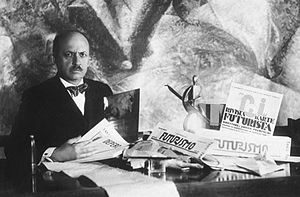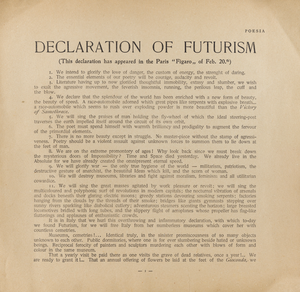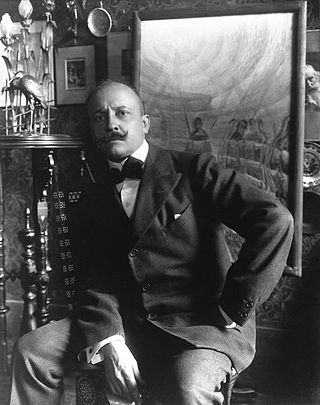
Filippo Tommaso Emilio Marinetti was an Italian poet, editor, art theorist, and founder of the Futurist movement. He was associated with the utopian and Symbolist artistic and literary community Abbaye de Créteil between 1907 and 1908. Marinetti is best known as the author of the first Futurist Manifesto, which was written and published in 1909, and as a co-author of the Fascist Manifesto, in 1919.

Futurism was an artistic and social movement that originated in Italy, and to a lesser extent in other countries, in the early 20th century. It emphasized dynamism, speed, technology, youth, violence, and objects such as the car, the airplane, and the industrial city. Its key figures included the Italians Filippo Tommaso Marinetti, Umberto Boccioni, Carlo Carrà, Fortunato Depero, Gino Severini, Giacomo Balla, and Luigi Russolo. Italian Futurism glorified modernity and according to its doctrine, aimed to liberate Italy from the weight of its past. Important Futurist works included Marinetti's 1909 Manifesto of Futurism, Boccioni's 1913 sculpture Unique Forms of Continuity in Space, Balla's 1913–1914 painting Abstract Speed + Sound, and Russolo's The Art of Noises (1913).

Giacomo Balla was an Italian painter, art teacher and poet best known as a key proponent of Futurism. In his paintings, he depicted light, movement and speed. He was concerned with expressing movement in his works, but unlike other leading futurists he was not interested in machines or violence with his works tending towards the witty and whimsical.

Italian futurist cinema was the oldest movement of European avant-garde cinema. Italian futurism, an artistic and social movement, impacted the Italian film industry from 1916 to 1919. It influenced Russian Futurist cinema and German Expressionist cinema. Its cultural importance was considerable and influenced all subsequent avant-gardes, as well as some authors of narrative cinema; its echo expands to the dreamlike visions of some films by Alfred Hitchcock.
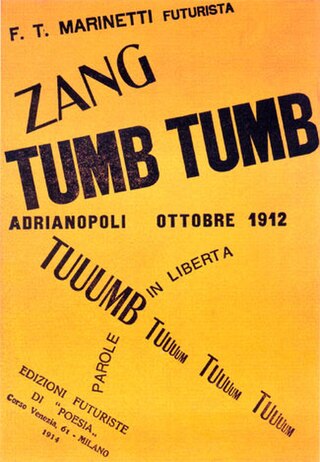
Zang Tumb Tumb is a sound poem and concrete poem written by Filippo Tommaso Marinetti, an Italian futurist. It appeared in excerpts in journals between 1912 and 1914, when it was published as an artist's book in Milan. It is an account of the Battle of Adrianople, which he witnessed as a reporter for L'Intransigeant. The poem uses Parole in libertà and other poetic impressions of the events of the battle, including the sounds of gunfire and explosions. The work is now seen as a seminal work of modernist art, and an enormous influence on the emerging culture of European avant-garde print.
"[The] masterpiece of Words-in-freedom and of Marinetti’s literary career was the novel Zang Tumb Tuuum... the story of the siege by the Bulgarians of Turkish Adrianople in the Balkan War, which Marinetti had witnessed as a war reporter. The dynamic rhythms and onomatopoetic possibilities that the new form offered were made even more effective through the revolutionary use of different typefaces, forms and graphic arrangements and sizes that became a distinctive part of Futurism. In Zang Tumb Tuuum; they are used to express an extraordinary range of different moods and speeds, quite apart from the noise and chaos of battle.... Audiences in London, Berlin and Rome alike were bowled over by the tongue-twisting vitality with which Marinetti declaimed Zang Tumb Tuuum. As an extended sound poem it stands as one of the monuments of experimental literature, its telegraphic barrage of nouns, colours, exclamations and directions pouring out in the screeching of trains, the rat-a-tat-tat of gunfire, and the clatter of telegraphic messages." — Caroline Tisdall and Angelo Bozzola

Futurist architecture is an early-20th century form of architecture born in Italy, characterized by long dynamic lines, suggesting speed, motion, urgency and lyricism: it was a part of Futurism, an artistic movement founded by the poet Filippo Tommaso Marinetti, who produced its first manifesto, the Manifesto of Futurism, in 1909. The movement attracted not only poets, musicians, and artists but also a number of architects. A cult of the Machine Age and even a glorification of war and violence were among the themes of the Futurists - several prominent futurists were killed after volunteering to fight in World War I. The latter group included the architect Antonio Sant'Elia, who, though building little, translated the futurist vision into an urban form.
Futurist meals comprised a cuisine and style of dining advocated by some members of the Futurist movement, particularly in Italy. These meals were first proposed in Filippo Tommaso Marinetti and Luigi Colombo (Fillìa)'s Manifesto of Futurist Cooking, published in Turin's Gazzetta del Popolo on December 28, 1930. In 1932, Marinetti and Fillìa expanded upon these concepts in The Futurist Cookbook.

Valentine de Saint-Point was a French writer, poet, painter, playwright, art critic, choreographer, lecturer and journalist. She is primarily known for being the first woman to have written a futurist manifesto. Additionally, she was also active in Parisian salons and the associated literary and artistic movements of the Belle Epoque. Her writings and performances of La Métachorie demonstrated her theory of "a total fusion of the arts." Performed veiled, it is an exploration of the body's relationship to nature and geometric archetypes that govern physical form and movement. Finding a similar universality in Islamic art, she converted to Islam and moved to Alexandria where she also became involved in Middle Eastern politics, writing prolifically as an advocate for Egyptian and Syrian independence from French rule. She died at the age of 78. Her Muslim name was Ruhiyya Nur al-Din and she is buried next to the Imam al-Shafii.

Gerardo Dottori was an Italian Futurist painter. He signed the Futurist Manifesto of Aeropainting in 1929. He was associated with the city of Perugia most of his life, living in Milan for six months as a student and in Rome from 1926-39. Dottori's' principal output was the representation of landscapes and visions of Umbria, mostly viewed from a great height. Among the most famous of these are Umbrian Spring and Fire in the City, both from the early 1920s; this last one is now housed in the Museo civico di Palazzo della Penna in Perugia, with many of Dottori's other works. His work was part of the art competitions at the 1932 Summer Olympics and the 1936 Summer Olympics.

Fillìa was the name adopted by Luigi Colombo, an Italian artist associated with the second generation of Futurism. Aside from painting, his works included interior design, architecture, furniture and decorative objects.
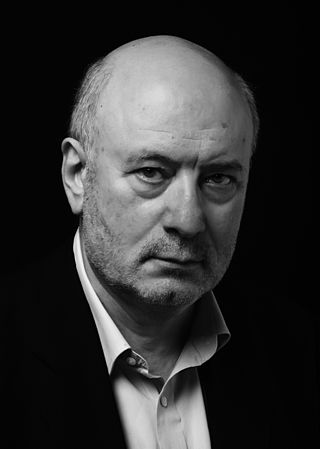
Giovanni Lista is an Italian art historian and art critic, resides in Paris. He is a specialist in the artistic cultural scene of the 1920s, particularly in Futurism.

Aeropittura (Aeropainting) was a major expression of the second generation of Italian Futurism, from 1929 through the early 1940s. The technology and excitement of flight, directly experienced by most aeropainters, offered aeroplanes and aerial landscape as new subject matter.
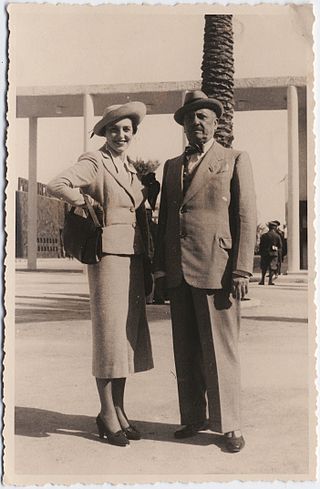
Benedetta Cappa was an Italian futurist artist who has had retrospectives at the Walker Art Center and the Solomon R. Guggenheim Museum. Her work fits within the second phase of Italian Futurism.

Girl Running on a Balcony is a 1912 painting by Giacomo Balla, one of the forerunners of the Italian movement called Futurism. The piece indicates the artist's growing interests in creative nuances which would later formally be realized as part of the Futurist movement. The artist was heavily influenced by northern Italians' use of Divisionism and the French's better-known pointillism. Created with oil on canvas just on the brink of World War I, the Futurist movement is embodied by a dark optimism for a future of speed, turbulence, chaos, and new beginnings. Most of Giacaomo Balla's pieces allude to the wonder of dynamic movement, and this painting is no exception. The oil painting is now in the Museo del Novecento, in Milan.
The Futurist Painting: Technical Manifesto (1910) by Umberto Boccioni (1882-1916) was the first exposition of the theoretical underpinnings of Italian Futurist painting.
The Futurist Political Party was an Italian political party founded in 1918 by Filippo Tommaso Marinetti as an extension of the futurist artistic and social movement. The party had a radical program which included promoting gender parity and abolishing marriage, inheritance, military service and secret police. The party was absorbed into the Fasci Italiani di Combattimento in 1919.

Růžena Zátková, also called Rougina Zatkova, was a painter and sculptor who has been regarded as the "only authentic Czech futurist." As a result of her Bohemian heritage and her decade-long residency in Rome, Růžena Zátková became an important artistic link between Russian and Italian Futurism. Zátková is considered one of the pioneers of kinetic art.
Ivo Pannaggi was an Italian painter and architect who was active in the Futurist movement and later associated with the Bauhaus.

Omero Vecchi, known by his pen name Luciano Folgore, was an Italian poet.
Prometeo was a monthly avant-garde magazine which existed between 1908 and 1912 in Madrid, Spain. The magazine was established by the avant-garde writer Javier Gómez de la Serna. Its subtitle was revista social y literaria.
